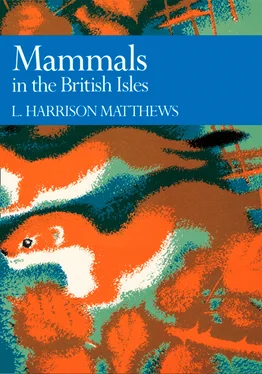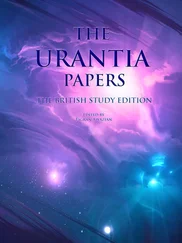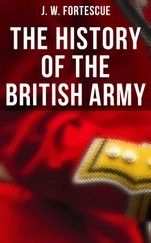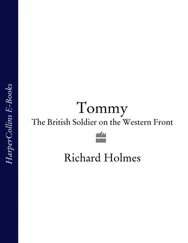

In all the glacial stages there were at least two maxima of cold separated by less cold interstadial intervals, and similarly in the interglacial stages the climate fluctuated between cold, temperate, and warm. The beginnings and ends of the glacial stages were gradual, so that as the ice retreated after a glaciation the land was at first polar desert becoming steppe or tundra as the temperature rose; it was then invaded by open boreal forest with birch and pine dominant, which in turn was replaced by dense deciduous forest with alder, oak, ash and other broad-leaved trees. As a glacial stage approached the succession was reversed.
| Epoch |
British Isles |
Climate |
| Holocene |
Flandrian |
Temperate |
| Upper Pleistocene |
Devensian Ipswichian Wolstonian |
Glacial with permafrost Temperate Glacial with permafrost |
| Middle Pleistocene |
Hoxnian Anglian Cromerian Cromerian Cromerian |
Temperate Glacial with permafrost Temperate Cold with permafrost Warm |
| Lower Pleistocene |
(Gap) (ca. 1 M. years) |
Cold with permafrost Temperate Cold Temperate |
| Baventian Antian Thurnian Ludhamian |
| (Gap) (ca. 1/2 M. years) |
| Pliocene |
Waltonian |
|
Fig. 4. Stages of the Pleistocene in the British Isles.
Apart from the climatic changes correlated with the glaciations and producing their advances and retreats, there were during the Pleistocene great changes in the level of the sea in relation to the land. The enormous masses of water withdrawn from circulation and locked up in the form of ice caused a fall in sea level of many hundreds of feet – indeed, it is reckoned that if all the ice even now in the form of glaciers and ice-caps were to melt the level of the sea would rise about three hundred feet. 155On the other hand the land is depressed towards sea level during glaciation by the sheer weight of ice resting upon it. At the same time there has been throughout the Pleistocene from time to time a slow upraising or lowering of the land, the eustatic movements of the tectonic plates.
An important consequence of these changes in sea level, whether caused by withdrawal of liquid water or by movement of the land, was that the British Isles were periodically part of the continent of Europe so that they shared its fauna and flora. Thus the bed of the southern part of the North Sea has for long periods been dry land, and the final opening of the Straits of Dover did not come about until some seven thousand years ago. One cannot help wondering whether this was a sudden dramatic happening in some furious equinoctial gale when low atmospheric pressure and a high spring tide combined with a surge such as those that have brought disastrous floods to East Anglia in recent times, broke the crumbling barrier and sent the waters of the North Sea pouring over into the English Channel – or whether an unusually high tide crept over a low dune between the salt marshes on each side so that the waters met and mixed with so little fuss that no one would have noticed.
The connection with the continent facilitated the return of the flora and fauna after it had been exterminated by each glaciation. At the time of the greatest glaciation some 450,000 years ago an unbroken sheet of ice covered the whole of northern Europe, including the British Isles, except southern England south of a line joining the Thames to the mouth of the Severn. 61The part left free of ice was deeply covered with winter snow, and the sea was full of floating ice. It is doubtful if any of the flora or fauna was able to live there; certainly no mammals could survive, and consequently our present fauna must have arrived after the ice of the great glaciation retreated.
Subsequent glaciations were less extensive so that the midlands as far north as York and the southern part of Ireland were free of ice and provided a possible habitat for those species that could withstand the arctic or subarctic conditions. The changes in flora and fauna are sometimes spoken of as retreats to more congenial climates in the south during the glaciations – the distribution of the plants and animals retreated, but there was no physical movement of individuals, they were merely killed. The return during interglacials was different; the flora gradually spread in by the usual manner of seed dispersal, but the animals and especially the mammals did move in ‘on the hoof’, not as mass migrations but in the course of populations extending their ranges under pressure of numbers as new habitats became available.
The amount of extermination among the mammalian species even in the last glaciation, which did not blanket the whole of the British Isles and ended some twelve to ten thousand years ago, is shown by comparing the 167 species of land mammal now living in western Europe with the 41 of Great Britain and the 21 of Ireland. 151Our fauna is not so much ‘impoverished’ as incomplete; there was not a long enough period of time before the breaching of the Straits of Dover for more species to extend their range into the islands. As H. W. Bates, the naturalist of the Amazon and later for many years secretary of the Royal Geographical Society, said in 1878, the British Isles are ‘a half starved fragment of the Palaearctic’. 18
Many methods are now used for dating the events of the Pleistocene: geological methods such as the study of varves, the annual variation in the composition of deposits giving laminated sediments in freshwater lakes; investigation of the palaeomagnetism of rocks; and chemical methods such as radio-carbon dating of organic material derived from living organisms, and potassium-argon dating for older rocks. But in tracing the changes in the composition of the flora and fauna the discovery and study of the fossil or subfossil remains of the plants and animals themselves provides the most important evidence. If the horizons in which mammalian remains are recovered are accurately recorded it is possible to know the composition of the fauna from time to time, and to infer much about the conditions of the environment – when, for example, hippopotamuses lived in the Thames before the Devensian glaciation the climate was, presumably, much warmer than at present.
On the other hand the presence of various species of elephant need not of necessity imply that the climate was warm; the order Proboscidea, now reduced to only two species facing extermination in the not too distant future, was once numerous in species some of which were no doubt able to live in temperate or even cold climates provided there was sufficient vegetation for their food – it does not follow that all were warm climate creatures because their living relatives are. Indeed the mammoth, which was clothed in a warm coat of shaggy hair, was an inhabitant of cold regions. Similarly the woolly rhinoceros, which also had long hair, was present with the mammoth in the last cold interstadial of the Devensian glaciation. 155But hair on rhinoceroses does not imply that the animals live in cold climates for the hairiest of the living species, the Asiatic two-horned rhinoceros, lives in tropical south east Asia.
The hair sticking to the frozen remains of mammoths found in Siberia is red, but may have been darker or brown in life, for the pigments in long-preserved hair, especially when buried, undergo a change towards an auburn red – the hair of Egyptian mummies often has this tinge. The hair of Ben Jonson, who died in 1637, was found to be red when his skull with hair still attached was exposed in 1859 during the reburial in Westminster Abbey of the remains of John Hunter, the surgeon and anatomist. 26When the skull of Sir Thomas Browne, who died in 1682, was exhumed in 1840 the hair associated with it was ‘of a fine auburn colour’; before it was re-interred in the chancel of St Peter Mancroft, Norwich, in 1927 it was examined at the Royal College of Surgeons by H.L. Tildesley, 144who remarked that ‘hair of persons long buried is commonly found to have acquired a reddish tinge, whatever the original shade.’
Читать дальше














